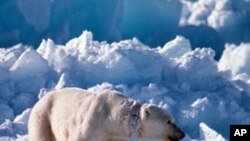More than two years after the Arctic polar bears were placed on an endangered species list, a new study concludes that reducing greenhouse gas emissions could save the animal.
Scientists from a number of institutions say significant reductions in greenhouse gas emissions over the next 10 or 20 years could leave enough Arctic sea ice intact during late summer and early autumn to save the polar bear.
An estimated 22,000 of the white bears remain in the world. The creatures were placed on an endangered species list in 2008, with environmentalists predicting that at least two-thirds of them would be gone by the middle of the century if global warming continued at its current pace.
Steven Amstrup is a senior researcher with the US Geological Survey and the Montana-based conservation group Polar Bears International.
"Many interpreted those findings as being irreversible," said Amstrup. "Polar bears were doomed and there was nothing we could do about it. And we wanted to test that hypothesis - Is there really anything that can be done to save polar bears?"
Polar bears rely on Arctic sea ice for hunting and it has been shrinking at a steady pace with the rise in global temperatures.
Amstrup says there's a widespread belief that the sea ice will continue to melt and the bears are a lost cause.
But that's not scientists found when they used a computer model to calculate the effect of several greenhouse gas emission reduction plans, according to Amstrup.
"Indeed, if greenhouse gas emissions were mitigated, that substantially more sea ice could be retained," said Amstrup. "And we determined that by retaining more sea ice, we would retain more polar bears."
Greenhouse gases, notably carbon dioxide from power plant and automobile emissions, are causing temperatures to rise at the North Pole.
Experts say polar bears are an important barometer of the environmental health of the Arctic ecosystem and offer scientists an opportunity to study the frigid terrain. For example, they hunt for seals and other animals that live beneath the ice and cannot be seen.
Andrew Derocher is an Arctic biologist at the University of Alberta in Canada. Derocher says the study's findings correct a widespread misunderstanding that nothing can be done to save polar bears.
"A lot of people had that impression for many years following the publication of the earliest work showing that polar bears are in dire trouble if we don't do something," said Derocher. "What this paper does is it tells us if we do something, we can keep polar bears and they'll do much better if we act. And the sooner we act, the better it is for the bears and the planet as a whole."
The study on polar bears and an accompanying news and view article by Andrew Derocher of the University of Alberta in Canada are published this week in the journal Nature.
News
Cutting Greenhouse Gases Could Avert Polar Bear Extinction
